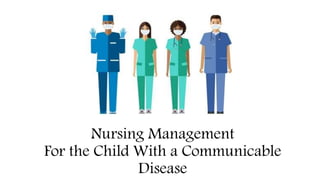
NURSING MANAGEMENT OF CHILDREN WITH COMMUNICABLE DISEASES
- 1. Nursing Management For the Child With a Communicable Disease
- 2. Introduction
- 3. Nursing assessment • History • Recent exposure to a known case • Prodromal symptoms (symptoms that occur between early manifestations of the disease and its overt clinical syndrome) or evidence of constitutional symptoms, such as a fever or rash. • Immunization history • History of having the disease
- 4. Nursing Assessment • Examinations • Assess the child’s • Hydration status and fluid intake • Vital signs • Comfort level and appetite. • Observe for • Seizures and toxic appearance (lethargy, poor perfusion, hypoventilation or hyperventilation, and cyanosis). • The child with a fever may be • Irritable and restless, sleep fitfully, and have nonspecific muscular pain.
- 5. Nursing Assessment • Identify febrile children who may be at higher risk for a serious illness • Infants and children having a toxic appearance. • Newborns less than 28 days of age with a temperature over 38.0°C (100.4°F). • Children less than 4 years of age with a temperature over 41.0°C (105.8°F). • Children with conditions such as a congenital heart disease, ventriculo- peritoneal shunt, asplenia, and sickle cell disease. • Observe the child for other signs of infection, • Such as a rash, nausea and vomiting, or diarrhea, as well as generalized symptoms of a poor appetite, muscle aches, and malaise.
- 6. Nursing diagnosis • Hyperthermia related to infectious disease process • Impaired Skin Integrity related to skin lesions and scratching • Impaired Oral Mucous Membrane related to infectious disease process • Fluid Volume deficit related to repeated episodes of vomiting and diarrhea • Ineffective Family Health Management related to complexity of care required by child
- 7. Planning and Implementation • Nursing care • Collecting cultures • Providing supportive care • Administering antibiotics on schedule • Monitoring antibiotic blood levels if indicated to ensure appropriate results • Promoting the child’s comfort, and • Educating parents
- 8. Prevent Disease Transmission • Isolate children with suspicious rashes and respiratory infections. • Cover draining wounds and dispose of dressings appropriately. • All items with which the infected child comes into contact are considered contaminated (e.g., linens, toys, medical equipment). • Use standard precautions and good hand hygiene. • Recall that the fecal–oral and respiratory routes are the most common routes of transmission in children. • Wipe down hard surfaces in the examining room with an antiseptic solution before another child uses the room.
- 9. Prevent Disease Transmission • Wipe down toys in the waiting room daily with a nontoxic antiseptic solution. • Dispose of linens in appropriately marked linen bags. • Ensure that all healthcare providers are fully immunized or that unimmunized • Pregnant healthcare providers are not exposed to children with certain infections (e.g., Pertussis, rubella, or varicella)
- 10. Fever Management • Removing unnecessary clothing. • Encouraging increased fluid intake. • Administering non-aspirin antipyretics. • Identify clear fluids the child prefers to drink to encourage greater intake. • Parents often fear a fever, provide information and reassurance. • Help them to recognize signs that the child’s condition is worsening.
- 11. Educating the Family • Home care • Medications • Prevention of transmission • Comfort • Fluid intake • Skin care
- 12. Educating the Family • Medications • To give antipyretics and antibiotics if ordered • Teach parents to give all the antibiotic doses for the full number of days prescribed (Antibiotic resistance) • When over-the-counter medications may be used
- 13. Educating the Family • Prevention of transmission • Educate parents about methods to reduce disease transmission in the home. • Encourage parents to limit the exposure of family members, those with impaired immunity • Make sure that the ill child’s dishes and utensils are washed in hot soapy water or sanitized in a dishwasher. • Place dressings with drainage in a plastic bag for disposal to prevent contact by other family members.
- 14. Educating the Family • Comfort • Encourage children to rest. • Provide quiet diversional activities such as board games, computer games, DVDs, and music. • Fluid intake • Promote fluid intake and provide foods that the child prefers and do not cause discomfort.
- 15. Educating the Family • Skin care • Reduce itching of rashes with lukewarm baths with Aveeno or oatmeal and topical lotions. • Keep the child’s hands clean and nails trimmed. • Cover the hands with clean socks or mittens if scratching cannot be controlled.
- 16. Evaluation • Expected outcomes of nursing care include the following: • Opportunities for spread of infection between clients and family members are minimized. • The child’s fever is effectively managed with antipyretics. • The full treatment with antibiotics, if ordered, is completed
